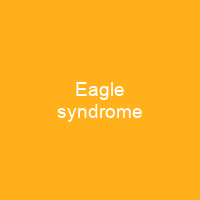The condition was first described by American otorhinolaryngologist Watt Weems Eagle in 1937. It is caused by an elongated or misshapen styloid process. Symptoms include sudden, sharp nerve-like pain in the jaw bone and joint.
About Eagle syndrome in brief

In vascular Eagle syndrome, the elongated styloid. process comes in contact with the internal carotid artery below the skull. In these cases, turning the head can cause compression of the artery or a tear inside the blood vessel, which restricts blood flow and can potentially lead to a transient ischemic attack or stroke.
You want to know more about Eagle syndrome?
This page is based on the article Eagle syndrome published in Wikipedia (as of Jan. 11, 2021) and was automatically summarized using artificial intelligence.







